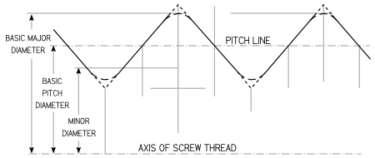What is the meaning of thread pitch, major diameter, minor diameter, crest, root, flanks, angle, and run-out in the context of external thread?
 Portland Bolt forms threads using two methods: cut threading and roll threading. Cut threading is a process that removes steel to form the threads. The roll threading method we utilize starts with reduced body pitch diameter steel. To make a one inch bolt we would use .912 inch round bar. This steel is forced between two dies and the steel is extruded to form the threads.
Portland Bolt forms threads using two methods: cut threading and roll threading. Cut threading is a process that removes steel to form the threads. The roll threading method we utilize starts with reduced body pitch diameter steel. To make a one inch bolt we would use .912 inch round bar. This steel is forced between two dies and the steel is extruded to form the threads.
Even though finished threads from either method function similarly, it would be difficult for an untrained eye to tell visually the differences. Cut threads are formed to UN (Unified National) and rolled threads are made to UNR (Unified National Radius) standards. According to the IFI (2003, A-33) abstract of ASME B1.1 2002, “…the difference between UN and UNR threads in addition to designation is that a flat or optional rounded root contour is specified for UN threads, while only a rounded root contour is specified for UNR threads.” In most cases cut threads will have a flat thread crest (top portion) and rolled threads will have rounded crest. Typical construction fasteners are designed to coarse thread series (UNC/UNRC).
Thread Terminology
According to IFI (2003, A-33) pitch diameter is, “the diameter of a theoretical cylinder that passes through the threads in such a position that the widths of the thread ridges and the grooves are equal. On a perfect thread these widths would each equal one-half of the thread pitch.”
The thread pitch is the distance, measured parallel to its axis, between corresponding points on adjacent surfaces, in the same axial plane. For unified threads, thread pitch is the reciprocal of threads per inch (TPI).
The major diameter of a thread is the distance that touches the crest of an external thread.
The minor diameter (root diameter) is the diameter of a cylinder that just touches the roots of an external thread.
The crest of a thread is the top portion of a thread.
The root is the lowest groove between the two flanks of the thread.
The flanks of a thread are the sides that connect the crest and the root.
The angle of a thread is the angle between the flanks, measured in an axial plane section.
The thread run-out describes the end of the threaded portion which is not cut or rolled to the full depth and provides a transition to bolt shank.
This is only a basic summary of the main characteristics of external threads. For more in-depth explanation see ASME B1.1 or Inch Fastener Standards from IFI (Screw Threads, 2003, Section A) for detailed description of threaded mechanical fasteners.

